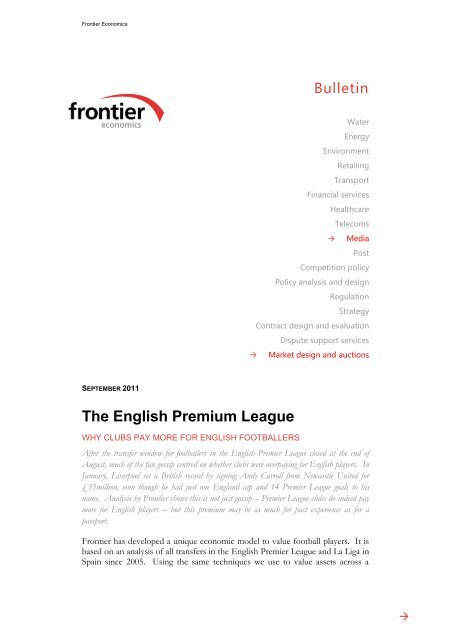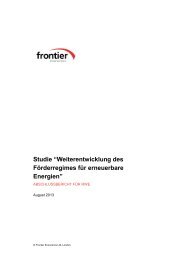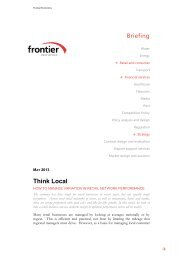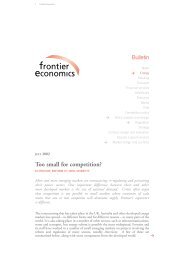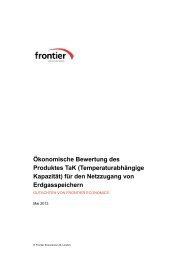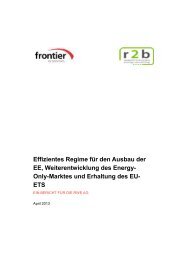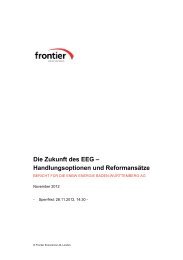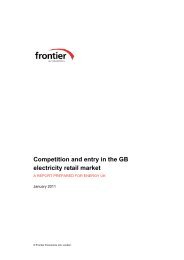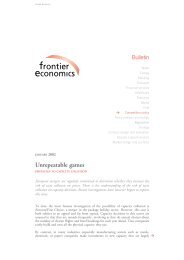The English Premium League - Frontier Economics
The English Premium League - Frontier Economics
The English Premium League - Frontier Economics
You also want an ePaper? Increase the reach of your titles
YUMPU automatically turns print PDFs into web optimized ePapers that Google loves.
<strong>Frontier</strong> <strong>Economics</strong><br />
SEPTEMBER 2011<br />
<strong>The</strong> <strong>English</strong> <strong>Premium</strong> <strong>League</strong><br />
WHY CLUBS PAY MORE FOR ENGLISH FOOTBALLERS<br />
Bulletin<br />
Water<br />
Energy<br />
Environment<br />
Retailing<br />
Transport<br />
Financial services<br />
Healthcare<br />
Telecoms<br />
Media<br />
Post<br />
Competition policy<br />
Policy analysis and design<br />
Regulation<br />
Strategy<br />
Contract design and evaluation<br />
Dispute support services<br />
Market design and auctions<br />
After the transfer window for footballers in the <strong>English</strong> Premier <strong>League</strong> closed at the end of<br />
August, much of the fan gossip centred on whether clubs were overpaying for <strong>English</strong> players. In<br />
January, Liverpool set a British record by signing Andy Carroll from Newcastle United for<br />
£35million, even though he had just one England cap and 14 Premier <strong>League</strong> goals to his<br />
name. Analysis by <strong>Frontier</strong> shows this is not just gossip – Premier <strong>League</strong> clubs do indeed pay<br />
more for <strong>English</strong> players – but this premium may be as much for past experience as for a<br />
passport.<br />
<strong>Frontier</strong> has developed a unique economic model to value football players. It is<br />
based on an analysis of all transfers in the <strong>English</strong> Premier <strong>League</strong> and La Liga in<br />
Spain since 2005. Using the same techniques we use to value assets across a
2 <strong>Frontier</strong> <strong>Economics</strong> | September 2011<br />
range of industries, we can model the value of players based on twenty indicators<br />
of performance and other characteristics such as position and age.<br />
This model allows us to estimate how much players are worth and test claims<br />
about how the market is developing. So, with this summer’s newspapers full of<br />
stories of Premier <strong>League</strong> clubs overpaying for <strong>English</strong> players, is it true that<br />
players are being transferred at a premium?<br />
In some, cases, the answer is a clear “yes”. Our model valued Andy Carroll at<br />
£14million, suggesting Liverpool could have overpaid by £21million when they<br />
paid a record fee of £35m in January. But, as the table below shows, Liverpool is<br />
not alone. On average, <strong>English</strong> players went for 80% more than we estimate<br />
they are worth. (Interestingly, even non-<strong>English</strong> players also went for a smaller<br />
premium of 5%, suggesting Premier <strong>League</strong> Clubs pay more for a player, on<br />
average, than the Spanish La Liga Clubs who are also included in our model).<br />
<strong>Premium</strong> for players bought by Premier <strong>League</strong> clubs, summer 2011<br />
<strong>The</strong> <strong>English</strong> <strong>Premium</strong> <strong>League</strong><br />
<strong>English</strong> players Non-<strong>English</strong> players<br />
Number of transfers 29 52<br />
Total spend on transfers £160m £320m<br />
Total estimated value £85m £300m<br />
<strong>Premium</strong> £75m £20m<br />
% <strong>Premium</strong> 80% 5%<br />
HOME-GROWN TALENT<br />
<strong>The</strong>re are a couple of possible explanations for an <strong>English</strong> premium. First,<br />
<strong>English</strong> players are more settled professionally and personally in the UK. And so<br />
they may be less risky investments than foreign players who have outstanding<br />
records in other leagues but who have not proved themselves in <strong>English</strong> football.<br />
Some big-money foreign players have flopped in the Premier <strong>League</strong>. After<br />
Manchester United signed Argentine superstar Juan Sebastian Veron for a then<br />
record £28million in 2001, he was sold to Chelsea for £15million just two years<br />
later after he failed to adjust to the <strong>English</strong> game.<br />
<strong>The</strong> other possible explanation is more “regulatory impact” than “competitive<br />
dynamic”. Since 2010-11, the Premier <strong>League</strong> has had a home-grown player rule,<br />
which means clubs must include eight home-grown players in their squad, out of<br />
a total of 25. Home-grown players are not necessarily <strong>English</strong>, but must have<br />
been trained by a club in England or Wales for three years before their 21st<br />
birthday. Some clubs had few <strong>English</strong> players prior to the ruling. Arsenal had<br />
only three out of 28 in its squad of 2008-09. <strong>The</strong> rule could therefore have<br />
increased demand for home-grown players, possibly pushing up prices.
3 <strong>Frontier</strong> <strong>Economics</strong> | September 2011<br />
We can try to split out these two effects by looking at the premium for non-<br />
<strong>English</strong> players who have experience in <strong>English</strong> football and those that do not.<br />
We can also see whether the premium has changed in the last couple of years<br />
following the introduction of the home-grown rule. <strong>The</strong> chart below illustrates<br />
the evolution of transfer premiums over the past five seasons.<br />
<strong>Premium</strong> for players bought by Premier <strong>League</strong> clubs since 2007-08, by value<br />
100%<br />
90%<br />
80%<br />
70%<br />
60%<br />
50%<br />
40%<br />
30%<br />
20%<br />
10%<br />
0%<br />
<strong>The</strong> chart shows that up until 2010-11 there was a clear premium of 20-30% for<br />
both <strong>English</strong> players and non-<strong>English</strong> players who have experience in <strong>English</strong><br />
football. This suggests that even if clubs initially pay as much for an average<br />
<strong>English</strong> player as an outstanding new import, to the upset of fans, a foreign star<br />
who continues to perform in the Premiership would quickly see his value rise<br />
above an average <strong>English</strong>man.<br />
But this summer has indeed been exceptional with a premium of 55% for<br />
<strong>English</strong> players above even foreign players experienced in England. This might<br />
suggest the home-grown rule is having an impact, as clubs short of <strong>English</strong><br />
players bid prices up, although why this impact would only show up a year after<br />
the rule was introduced isn’t clear.<br />
So it remains to be seen whether this reflects the start of a sustained – and<br />
artificially regulated – <strong>English</strong> premium, or whether this year’s crop of<br />
<strong>English</strong>man really are something special.<br />
CONTACT<br />
2007-2008 2008-2009 2009-2010 2010-2011 2011-2012<br />
Non-<strong>English</strong> fresh to <strong>English</strong> football Non-<strong>English</strong> experienced in <strong>English</strong> football <strong>English</strong> players<br />
Paul Cullum paul.cullum@frontier-economics.com<br />
Chris Cuttle chris.cuttle@frontier-economics.com<br />
Jorge Esteban Leon jorge.esteban-leon@frontier-economics.com<br />
<strong>Frontier</strong> <strong>Economics</strong> Ltd<br />
FRONTIER ECONOMICS EUROPE BRUSSELS | COLOGNE | LONDON | MADRID<br />
www.frontier-economics.com


